|
|
|
Sort Order |
|
|
|
Items / Page
|
|
|
|
|
|
|
| Srl | Item |
| 1 |
ID:
174560
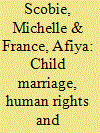

|
|
|
|
|
| Summary/Abstract |
The United Nations Convention on the Rights of the Child entered into force in 1990. It condemns child marriage, violence and discrimination against children and enjoins tutelage for their education and health. Implementing such principles in national legislation sometimes conflicts with local norms relating to respect for cultural and religious traditions. This was the case of Trinidad and Tobago, a multicultural and multi-religious society that legally sanctioned child marriage until 2017. The paper makes two unique contributions to the literature. First, using the literature on child marriage and the obligations under international conventions, the paper creates a child marriage conceptual framework with the main normative positions on child marriage. Second, using the framework, it explores the normative motivations underlying the domestic legal reform debates held in parliament between 2015–2017. The paper uses the conceptual framework to explain the transformations in the traditional positions of local religious and ethnic groups, provides evidence of norm penetration from the international to a local multicultural setting and furthers the literature on international human rights norm penetration and contestation.
|
|
|
|
|
|
|
|
|
|
|
|
|
|
|
|
| 2 |
ID:
180694
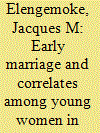

|
|
|
|
|
| Summary/Abstract |
Though several countries have adopted the sexual violence law which criminalizes child marriage, the practice of early marriage persists in Sub-Saharan Africa. This paper examined the socio-economic and demographic determinants of early marriage among young women in four Sub-Saharan African (SSA) countries, namely Niger, Democratic Republic of Congo, Mali and Malawi. Descriptive and multivariate analyses were performed to show that young women without formal education have 1.62, 1.59, 1.55 and 2.08 times more risk of early union than their secondary or higher educated counterparts. The study recommends the implementation of a universal, free and compulsory basic education in SSA countries.
|
|
|
|
|
|
|
|
|
|
|
|
|
|
|
|
| 3 |
ID:
168482
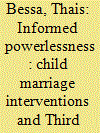

|
|
|
|
|
| Summary/Abstract |
Child marriage has gained increased international prominence over the past decades. Organisations working with the issue have promoted empowering girls as the best strategy to address it. Informed by postcolonial feminist theory, this article will locate these discourses in broader ‘turn to the girl’ and ‘turn to agency’ in international development, analysing how Third World girlhood, agency, resistance and voice are conceptualised. Girls are constructed as threatened by their families and communities, with agency exercised through resistance and materialised by their voice. I argue that this ignores the complexity of decision-making processes and broader structural factors related to child marriage, so that interventions providing ‘empowerment-as-information’ for girls to be agents of change instead leave them in a state of informed powerlessness.
|
|
|
|
|
|
|
|
|
|
|
|
|
|
|
|
| 4 |
ID:
153130
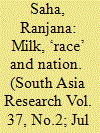

|
|
|
|
|
| Summary/Abstract |
This article analyses medical opinion about nursing of infants by memsahibs and dais as well as the Bengali-Hindu bhadramahila as the ‘immature’ child-mother and the ‘mature’, ‘goddess-like’ mother in the tropical environment of nineteenth and early twentieth century Bengal. It shows how the nature of lactation, breast milk and breastfeeding are socially constructed and become central to medical advice on motherhood and childcare aimed at regenerating community, ‘racial’ and/or national health, including manly vigour for imperial, colonial and nationalist purposes. In colonial Bengal, the topic of breastfeeding surfaces as crucial to understanding colonial and nationalist, medical and medico-legal representations of maternal and child health constituted by gendered, racialised, classed and caste-ridden, biological/cultural and pure/polluting traits, often considered transferable through milk and blood.
|
|
|
|
|
|
|
|
|
|
|
|
|
|
|
|
| 5 |
ID:
179122
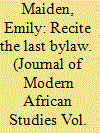

|
|
|
|
|
| Summary/Abstract |
In the study of modern chieftaincy in Africa, scholars have identified chiefs as important intermediaries for promoting increased voter turnout, new health policies and development initiatives. I add to this literature the importance of chiefs as cultural intermediaries. Using recent child marriage reform efforts in Malawi as a case study, I find that chiefs are key actors needed to implement culturally embedded policy changes. Drawing on descriptive evidence from 12 months of fieldwork across all three regions of Malawi, I find that chiefs are responsible for shifting cultural practices related to child marriage. Using a unique blend of democratic and non-democratic powers, chiefs in Malawi are defying expectations and using their position to promote girls’ rights. These findings contribute to our broader understanding of the political and cultural power of modern chiefs.
|
|
|
|
|
|
|
|
|
|
|
|
|
|
|
|
| 6 |
ID:
182865
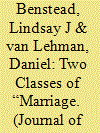

|
|
|
|
|
| Summary/Abstract |
Some Somali majority clan girls and women receive economic and security benefits from marriage to Al-Shabaab fighters. Yet, the literature treats women’s experiences monolithically and misses the role that race plays in determining the circumstances of such unions. The authors argue that one should not refer to the unions of Somali Bantu girls and women with Al-Shabaab fighters as a “marriage” but rather as sexual and domestic slavery – a form of extraction by Al-Shabaab that works to ethnically cleanse the Bantu from their ancestral land. Drawing on data from an original survey conducted in 2017 of 139 Somali Bantu refugee households who fled to Kenya during the previous year, the authors examine the nature and extent of unions between females from different races with Al-Shabaab fighters. Women and girls from majority clans are more likely to marry fighters freely. Compared to majority clan females, Somali Bantu girls are enslaved by Al-Shabaab fighters at younger ages and typically remain with their own families rather than moving to the man’s household, contrary to Somali’s patrilineal marriage customs. Al-Shabaab fighters do not claim the children they have with Somali Bantu girls and women, whom they despise as a racially distinct minority with low social status. This work underscores the need to avoid the term “marriage” when referring to the sexual slavery of minorities in Somalia by Al-Shabaab and for the international community both to investigate claims of ethnic cleansing as well as support the fledgling Somali government in establishing a system of rule of law.
|
|
|
|
|
|
|
|
|
|
|
|
|
|
|
|
| 7 |
ID:
076317
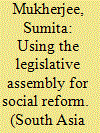

|
|
|
|
|
| Publication |
2006.
|
| Summary/Abstract |
In 1929, the Legislative Assembly of India, a body of representative Indian politicians, passed a law making the minimum age of marriage 14 years for girls. In contrast to the debates in the 1890s from which the 1891 Age of Consent Act was passed by the imperial legislature, there were intense debates in 1920s India involving British and Indian social reformers on the issue of marriage. Marriage affected the majority of the population and involved all communities, and this was the first legislation to impose a minimum age. Child marriage was seen in the eyes of some Indians and outsiders as an outdated and particularly harmful tradition, but many Hindus justified the practice as a religious necessity. The article explores how Indian reformers were able to defy opposition and use the new governing mechanisms given to them to pass legislation on a matter of national concern.
|
|
|
|
|
|
|
|
|
|
|
|
|
|
|
|
| 8 |
ID:
190883
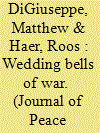

|
|
|
|
|
| Summary/Abstract |
Child marriage is a fundamental violation of human rights. It hinders progress towards development and public health goals. In this study, we argue that armed conflict plays an important role in the occurrence of child marriages; it influences the supply of and demand for young brides. We argue that in conflict settings, families are more willing to marry off their young daughters for protection. Armed conflict can also influence the demand: marriage in general declines due to an imbalance in sex ratio. However, in cases where belligerents use war tactics specifically focused on harming girls, such as sexual violence and girl recruitment, early marriage might increase as the result of armed conflict. To empirically examine these linkages, we combine the Demographic and Health Surveys of West Africa with information on the location of armed conflict. Our study shows that armed conflict generally reduces the occurrence of child marriage with 13% to 18%. However, we observe that when conflict actors use war tactics that specifically harm young girls there is a significant increase of 12% to 18% in the probability of a girl getting married before the age of 18. This research has important implications for our understanding of the relationship between armed conflict, gender inequality, and their impact on children.
|
|
|
|
|
|
|
|
|
|
|
|
|
|
|
|
|
|
|
|
|